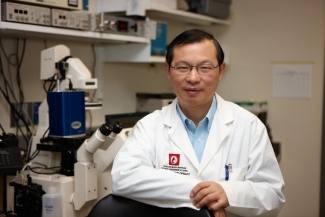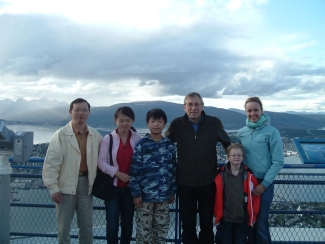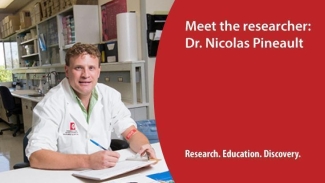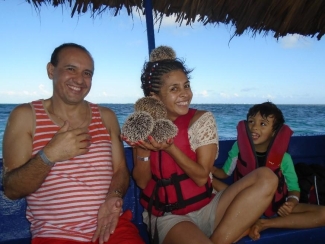[Updated Nov 6, 2018]
For this “Meet the researcher” post, we met with Dr. Heyu Ni, a scientist at Canadian Blood Services’ Centre for Innovation who is an expert in platelet immunology and clotting.
Congratulations to Canadian Blood Services scientist, Dr. Heyu Ni (St. Michael's Hospital, Toronto), on his successful application for a Canadian Institutes of Health Research Foundation Grant. This highly competitive, prestigious award provides long-term support for the pursuit of innovative, high-impact research programs. Dr. Ni was awarded 7-years' support for his project "Thrombosis and Thrombocytopenia: Novel mechanisms and treatments".
How long have you been with Canadian Blood Services?
I have been with Canadian Blood Services since July 2001.

What’s your role?
I am a scientist in the Canadian Blood Services Centre for Innovation. I’m also a full professor in the departments of laboratory medicine and pathobiology, medicine, and physiology at the University of Toronto, and a scientist at St. Michael's Hospital in Toronto, where I’m the platform director for hematology, cancer, and immunological diseases. My roles include discovering novel mechanisms and treatments for diseases related to transfusion medicine, as well as training students and disseminating knowledge in the field.
"During my MD training program and intern residency in the hospital, I saw many patients who passed away due to a lack of effective treatment. Ultimately, my curiosity, combined with a desire to save lives, drove me into science and research."
Dr. Heyu Ni, Scientist, Centre for Innovation, Canadian Blood Services
Where is your lab?
My research lab is located at St. Michael's Hospital in the Keenan Research Center, which is affiliated with the University of Toronto.
Tell us about your area(s) of research.
My research areas include platelet physiology and platelet immunology.
Platelet physiology:
When a blood vessel is injured, bleeding is stopped by two key mechanisms: coagulation and formation of a platelet plug. There are many interactions between the two mechanisms. For example, platelets accelerate coagulation by enhancing the generation of thrombin, an important coagulation protein. Conversely, thrombin generated by the coagulation process increases platelet activation.
Problems with coagulation or platelet function can be dangerous; many patients with bleeding disorders must be transfused with blood products to stop their bleeding. On the other hand, improper formation of a platelet plug may block blood vessels (thrombosis). Thrombosis in a coronary artery (heart attack) or cerebral artery (stroke) is the leading cause of morbidity and mortality worldwide. To control these life-threatening disorders, we are researching the mechanisms of bleeding and clotting.
Learn more about Dr. Ni’s research on clotting:
RED blog: Developing safer drugs for heart attack and stroke patients
RED blog: Highly ranked transfusion-related research projects get greenlight
Platelet immunology:
Autoimmune thrombocytopenia (ITP) is a bleeding disorder in which patients’ immune systems attack their own platelets, leading to uncontrolled bleeding and a poor quality of life. The current first-line treatments, intravenous immune globulin (IVIg) and steroid therapies, work well for some patients, but many patients are resistant. We are working to learn more about ITP, identify people who won’t respond to IVIg treatment, and develop alternative therapies.
Another bleeding disorder associated with platelet destruction is fetal and neonatal alloimmune thrombocytopenia (FNAIT). FNAIT can cause severe bleeding, such as intracranial hemorrhage (ICH), which can threaten the life of a fetus or newborn. FNAIT is poorly understood and current therapy has not yet been standardized. We are evaluating therapeutic efficacies of IVIg and fetal platelet transfusion as well as developing new therapies to control this devastating disease.
Learn more about Dr. Ni’s research on FNAIT:
ResearchUnit: Natural killers: when cells go wrong
ResearchUnit: Platelets vs. blood vessels: what causes bleeding in fetuses and newborns with FNAIT?
RED blog: New research reveals insights into causes of FNAIT
What are you working on now?
We have established cutting-edge microscopy technologies that allow direct monitoring of clot formation in real time in animal models. Using these techniques, we were the first to observe that platelet aggregation and clot formation still occur in the absence of several molecules believed to be essential for clotting: fibrinogen, von Willebrand factor, and plasma fibronectin. These surprising discoveries challenged the established theory of blood clotting and suggested that other unidentified molecule(s) are also involved. This could lead to the identification of novel targets for anti-thrombotic therapies and novel plasma proteins for transfusion to control bleeding. My team is in the process of identifying these mysterious molecules using several state-of-the-art techniques. We will then investigate the roles of these molecules in platelet biology, disease, and transfusion medicine.
Several of our recent papers (2012, 2014, 2015, 2017) have investigated how different types of ITP may respond differently to therapy (e.g. IVIg). This has important implications for human ITP and potential screening of patients in order to successfully treat this disease. In another series of publications (2010, 2011, 2015) we characterized the first animal model of FNAIT and examined its response to IVIg therapy. Currently, we are studying the molecular and cellular causes of ITP and FNAIT, including the maternal immune responses to fetal platelet antigens and the role of placental dysfunction in the disease progression of FNAIT. We have also developed several novel therapies and preventative treatments that have led to clinical trials in human patients.
Why did you get into science?
I have always been curious about nature and became interested in science when I was a child. During my MD training program and intern residency in the hospital, I saw many patients who passed due to a lack of effective treatment. Ultimately, my curiosity, combined with a desire to save lives, drove me into science and research.
What inspires you?
Interesting and unexpected observations from nature and experimental results are always inspiring, as well as communication with my trainees and colleagues. It is particularly rewarding to be involved in mentoring and guiding students towards improving their abilities as young researchers; this is something that I have always taken seriously.

What do you find most exciting about your work?
I am most excited when I find my scientific hypotheses are demonstrated to be true and lead to changes in the way we treat and think about disease. It can be very exciting to go through the entire process from developing an idea, testing it, publishing and eventually improving diagnosis, prevention, and therapy.
What work are you most proud of?
I am very proud of the many original discoveries that my group has been able to publish in high impact journals. My research on clotting (fibrinogen-independent platelet aggregation) and causes of ITP (Fc-independent platelet phagocytosis) has generated important contributions to medical science and transfusion medicine. I have also identified new therapeutic strategies with great potential to develop new treatments for ITP, FNAIT, and blood clotting. However, what I am most proud of are the many excellent students I have trained, who are also using their skills to contribute to medical sciences and patient care.
When you’re not in the lab where could we find you?
Travelling for scientific meetings is the most common reason that somebody may be not able to find me in the lab. If time allows, I also like sports such as fishing, skiing, and table tennis, as well as watching movies.

Subscribe to the Research & Education Round Up to stay up to date on research publications and funding opportunities.
Visit our Funded Research Projects page to view projects funded by Canadian Blood Services.
Canadian Blood Services – Driving world-class innovation
Through discovery, development and applied research, Canadian Blood Services drives world-class innovation in blood transfusion, cellular therapy and transplantation—bringing clarity and insight to an increasingly complex healthcare future. Our dedicated research team and extended network of partners engage in exploratory and applied research to create new knowledge, inform and enhance best practices, contribute to the development of new services and technologies, and build capacity through training and collaboration. Find out more about our research impact.
The opinions reflected in this post are those of the author and do not necessarily reflect the opinions of Canadian Blood Services nor do they reflect the views of Health Canada or any other funding agency.
Related blog posts
For the latest instalment of “Meet the researcher” we chatted with Dr. John Blake, Canadian Blood Services’ research engineer and also known as “the numbers guy”.
Dr. Pineault and his team are working on a cellular therapy to improve engraftment (the process through which new blood-forming cells start to develop in the patient) following cord blood stem cell transplantation.
This week, we catch up with Dr. Sandra Ramirez-Arcos, Canadian Blood Services’ development scientist and head of the microbiology laboratory in Ottawa. How long have you been with Canadian Blood Services? I started working at Canadian Blood Services on November 10, 2003, so it will be 15 years in...


